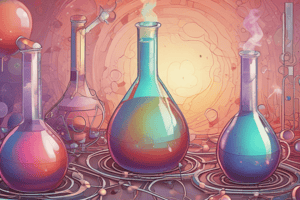Podcast
Questions and Answers
What occurs during a chemical reaction?
What occurs during a chemical reaction?
- Only chemical bonds are formed
- Chemical bonds are broken and formed (correct)
- Only chemical bonds are broken
- No chemical bonds are involved
What type of reaction involves the combination of two or more reactants to form a single product?
What type of reaction involves the combination of two or more reactants to form a single product?
- Combustion reaction
- Synthesis reaction (correct)
- Decomposition reaction
- Replacement reaction
What is the purpose of adding coefficients to a chemical equation?
What is the purpose of adding coefficients to a chemical equation?
- To identify the types of reactions
- To balance the equation (correct)
- To indicate the reactants
- To indicate the products
What is the type of chemical equation that shows only the species that participate in the reaction?
What is the type of chemical equation that shows only the species that participate in the reaction?
What is the law that states that the number of atoms of each element must be the same on both the reactant and product sides of the equation?
What is the law that states that the number of atoms of each element must be the same on both the reactant and product sides of the equation?
What is the correct order of steps to write a chemical equation?
What is the correct order of steps to write a chemical equation?
What type of reaction is represented by the equation 2CH₄ + 3O₂ → 2CO₂ + 3H₂O?
What type of reaction is represented by the equation 2CH₄ + 3O₂ → 2CO₂ + 3H₂O?
What is the purpose of a chemical equation?
What is the purpose of a chemical equation?
Flashcards are hidden until you start studying
Study Notes
Chemical Reactions
- A chemical reaction is a process where one or more substances (reactants) are converted into new substances (products).
- Chemical reactions involve the breaking and forming of chemical bonds.
- There are several types of chemical reactions:
- Synthesis reactions: two or more reactants combine to form a single product.
- Decomposition reactions: a single reactant breaks down into two or more products.
- Replacement reactions: one element replaces another element in a compound.
- Combustion reactions: a substance reacts with oxygen to produce heat and light.
Chemical Equations
- A chemical equation is a representation of a chemical reaction using chemical formulas and symbols.
- Chemical equations are written with reactants on the left and products on the right, separated by an arrow (→).
- The number of atoms of each element must be the same on both the reactant and product sides of the equation (Law of Conservation of Mass).
- Chemical equations can be balanced by adding coefficients (numbers in front of formulas) to ensure that the number of atoms of each element is the same on both sides.
- Types of chemical equations:
- Molecular equation: shows the reactants and products as molecules.
- Ionic equation: shows the reactants and products as ions.
- Net ionic equation: shows only the species that participate in the reaction.
Writing Chemical Equations
- Steps to write a chemical equation:
- Write the reactants on the left and products on the right.
- Use the correct chemical formulas and symbols.
- Count the number of atoms of each element on both sides.
- Add coefficients to balance the equation.
- Examples:
- Combustion reaction: 2CH₄ + 3O₂ → 2CO₂ + 3H₂O
- Synthesis reaction: 2H₂ + O₂ → 2H₂O
Chemical Reactions
- A chemical reaction involves the breaking and forming of chemical bonds to convert reactants into products.
Types of Chemical Reactions
- Synthesis reactions: combine two or more reactants to form a single product.
- Decomposition reactions: break down a single reactant into two or more products.
- Replacement reactions: one element replaces another element in a compound.
- Combustion reactions: a substance reacts with oxygen to produce heat and light.
Chemical Equations
- A chemical equation represents a chemical reaction using chemical formulas and symbols.
- Equations are written with reactants on the left and products on the right, separated by an arrow (→).
- The Law of Conservation of Mass ensures the number of atoms of each element is the same on both sides.
- Chemical equations can be balanced by adding coefficients to ensure equal atom count.
Types of Chemical Equations
- Molecular equation: shows reactants and products as molecules.
- Ionic equation: shows reactants and products as ions.
- Net ionic equation: shows only species that participate in the reaction.
Writing Chemical Equations
- Steps to write a chemical equation:
- Write reactants on the left and products on the right.
- Use correct chemical formulas and symbols.
- Count the number of atoms of each element on both sides.
- Add coefficients to balance the equation.
Examples of Chemical Equations
- Combustion reaction: 2CH₄ + 3O₂ → 2CO₂ + 3H₂O
- Synthesis reaction: 2H₂ + O₂ → 2H₂O
Studying That Suits You
Use AI to generate personalized quizzes and flashcards to suit your learning preferences.




